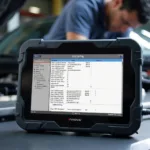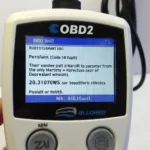OBD2 TID codes, or Test Identification codes, are a crucial part of advanced diagnostics in modern vehicles. They provide valuable insights into the specific tests performed by the vehicle’s onboard diagnostic system, helping pinpoint issues more accurately than standard OBD2 codes. This guide delves into the world of OBD2 TID codes, exploring their importance, how to access them, and what they reveal about your vehicle’s health.
What are OBD2 TID Codes?
OBD2 TID codes represent specific tests run by the vehicle’s onboard computer to monitor the performance of various systems and components. These tests are much more detailed than the standard OBD2 DTCs (Diagnostic Trouble Codes) and provide a deeper understanding of potential problems. While DTCs indicate a general fault, TIDs pinpoint the exact test that failed, allowing for a more precise diagnosis and quicker repair. They offer a granular view into the diagnostic process, helping mechanics identify intermittent issues or problems that might not trigger a DTC.
Imagine your car as a complex network of interconnected systems. Standard OBD2 codes are like a general alarm indicating something is wrong somewhere in the network. TID codes, on the other hand, act like specific sensors, highlighting the precise location of the malfunction within the network.
Accessing and Interpreting OBD2 TID Codes
Unlike standard OBD2 codes, which can often be accessed with basic code readers, retrieving TID codes typically requires more advanced scan tools and software. Professional-grade scanners, like those offered by ross tech obd2 software, are commonly used to access this data. The interpretation of TID codes also requires a deeper understanding of vehicle-specific diagnostic procedures and data parameters.
How to Access TID Codes
Accessing TID codes can vary depending on the vehicle make and model, and the specific diagnostic software used. Generally, it involves accessing the enhanced diagnostic functions within the software, selecting the relevant module (e.g., engine, transmission), and then navigating to the TID data section.
Understanding the Data
TID data often includes a code number, a description of the test performed, and the test results (pass/fail). Interpreting this data requires cross-referencing with manufacturer specifications and diagnostic procedures. This can be challenging for the average car owner, and expert assistance may be necessary.
Why are OBD2 TID Codes Important?
OBD2 TID codes play a vital role in advanced vehicle diagnostics. They offer several key benefits for mechanics and technicians:
- Precise Diagnosis: Pinpointing the exact test that failed allows for a more accurate diagnosis, eliminating guesswork and saving time.
- Early Detection: TIDs can identify potential problems before they escalate and trigger a DTC, enabling preventative maintenance.
- Intermittent Fault Detection: They can help diagnose intermittent issues that are difficult to reproduce or detect with standard OBD2 codes.
- Comprehensive System Analysis: Provides a deeper understanding of the overall health and performance of various vehicle systems.
What can you diagnose with obd2 tid cid codes? Anything from emissions issues to transmission problems.
Common Applications of OBD2 TID Codes
TID codes are especially useful in diagnosing complex systems such as:
- Emissions Systems: Identifying specific faults within the emissions system, such as catalytic converter efficiency or evaporative emissions leaks.
- Transmission Systems: Diagnosing issues with shift solenoids, torque converters, or other transmission components.
- Engine Management Systems: Pinpointing problems with fuel injection, ignition timing, or other engine-related parameters.
Sometimes, you might even find that obd2 monitor wheel bearing is possible using advanced diagnostics and TID codes.
“TID codes are invaluable for diagnosing intermittent problems,” says John Smith, Senior Automotive Diagnostician at Smith Automotive. “They allow us to see what’s happening in real-time, even if the problem isn’t present at the time of the scan.”
The Future of OBD2 TID Codes
As vehicle technology continues to evolve, the role of OBD2 TID codes will become increasingly important. With the growing complexity of modern vehicles, the need for more precise and detailed diagnostic information is paramount. TID codes, along with other advanced diagnostic tools, will continue to empower mechanics and technicians to effectively diagnose and repair even the most intricate automotive systems.
Conclusion
OBD2 TID codes provide a powerful tool for in-depth vehicle diagnostics. While accessing and interpreting them requires specialized knowledge and equipment, the benefits of precise diagnostics and early problem detection make them essential for maintaining the health and performance of modern vehicles. Understanding obd2 tid codes empowers both professionals and informed car owners to address automotive issues more effectively. For specific information on certain makes and models, you can check out resources like 1999 ford obd2 tid cid. As automotive technology advances, leveraging the power of TIDs will be crucial for accurate and efficient vehicle maintenance and repair.
FAQ
- What is the difference between a TID and a DTC?
- Do all vehicles support OBD2 TID codes?
- What kind of scanner do I need to access TID codes?
- Can I interpret TID codes myself?
- Where can I find more information on specific TID codes for my vehicle?
- Are TID codes used for emissions testing?
- What are the benefits of using TID codes for diagnostics?
Common Scenarios for Using OBD2 TID Codes
- Intermittent Check Engine Light: When the check engine light comes on sporadically, TID codes can help identify the underlying cause.
- Performance Issues: If the vehicle is experiencing performance issues, such as rough idling or hesitation, TIDs can pinpoint the specific system or component at fault.
- Pre-Purchase Inspection: Using TID codes during a pre-purchase inspection can reveal hidden problems that standard OBD2 codes might miss.
Further Reading
Need support? Contact us via WhatsApp: +1(641)206-8880, Email: [email protected] or visit us at 789 Elm Street, San Francisco, CA 94102, USA. Our customer support team is available 24/7.


